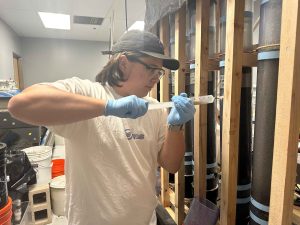Pilot phase completed for mechanistic study seeking to open BMP “black box”

SCCWRP and its partners have successfully completed the pilot testing phase for a three-year study working to characterize the mechanistic inner processes by which biofiltration stormwater BMPs (best management practices) treat stormwater pollutants.
The pilot phase, completed in April, consisted of a laboratory-scale experiment that showed that it is possible to pinpoint how specific measurable characteristics of biofiltration media – rather than media types – influence the systems’ effectiveness at removing dissolved copper from runoff.
Next, researchers will scale up the laboratory experiment to examine two additional biofiltration media types and other stormwater contaminants, including per- and poly-fluoroalkyl substances (PFAS). Later, researchers plan to validate the laboratory findings with experiments in the field.
The study’s goal is to open the “black box” that has historically surrounded how these BMP systems work, paving the way for managers to optimize their long-term performance.
More news related to: Emerging Contaminants, Stormwater BMPs